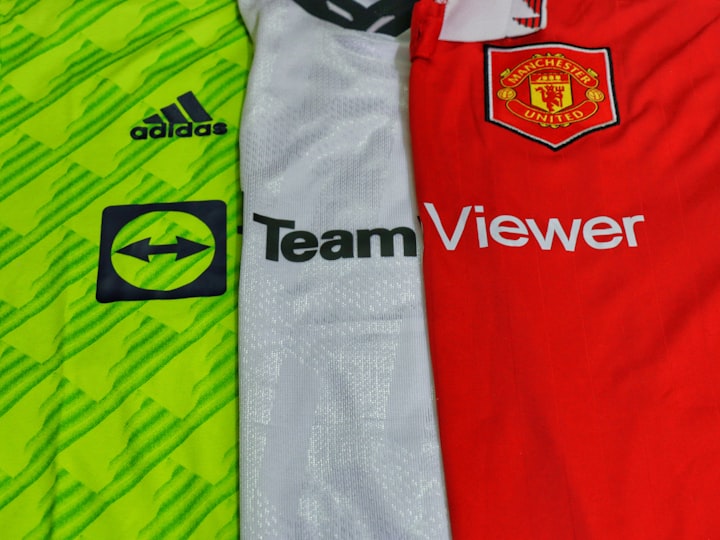Why Are Football Shirts So Expensive?
Overpriced or Not?

Every two seconds somebody buys a football shirt. And that’s just counting the shirts of the top ten clubs in Europe! Football shirts are big business. And they are getting more and more expensive. A Manchester United shirt today costs three times as much as thirty years ago! So, are greedy club owners ripping us off? It’s a bit more complicated than that. Let’s break down why football shirts are so expensive and who makes the most money selling them.
The Origin of Football Shirts
In the beginning, there were no uniforms. In the middle of the 19th century, when football first started to become popular, players would turn out in whatever they had to hand. Teams were simply distinguished by wearing colored caps or scarves. The first reference to "colors" comes from the rules of Sheffield FC, the oldest football club in the world, in 1857: "Each player must provide himself with a red and dark blue flannel cap, one color to be worn by each side." Soon, more and more clubs started to dye their shirts in club colors and sewed their logo to the chest. This original style lasted for almost a century. The only addition was numbers on the back, to make it easier for the fans to distinguish between players.
But in the 70s, just as everything around it, football started to become more colorful. Long before Inter Miami today, Palermo and Hamburg were playing in pink. And another thing changed. A deer showed up - to graze some fresh money. In 1973 German team Braunschweig became the first club to show a sponsor logo on its shirts – that of liquor producer Jägermeister. The move paid the team 100,000 German marks and introduced a new way of doing business to football that is worth millions today. But back then, many people hated the idea. The BBC refused to broadcast matches featuring sponsored shirts, forcing clubs to remove sponsors’ logos. That would quickly change when the broadcasters started getting a slice of the pie.
In the 90s, a lot of cash was injected into football through lucrative broadcasting deals. The marketing of replica kits exploded and everyone who considered him or herself to be a supporter was expected to turn out on matchday wearing the current replica kit. Shirts had to look good not only on the pitch but also when worn with jeans. Today, football shirts are fashionable. Collectibles with cultural significance. And a significant revenue stream for clubs. The biggest kit deals with Adidas and Nike bring clubs like Man Utd and Liverpool millions in cash each year. And all that money has to come from somewhere: the fans. So, clubs and brands are probably increasing prices whenever they can, right?
The Surprising Truth about the Prices
A typical football shirt today does indeed cost around three times as much as thirty years ago. But there is one very obvious reason for the change: inflation. According to the bank of England, the average inflation since 92 has been 2.8%. If you factor that in, €30 back then would be around 70 euros in today’s money. And that’s pretty much what you pay for a replica shirt today. That doesn’t mean that 70 euros for a football shirt are cheap, but it’s also not like we’ve missed out on a better time - the typical football shirt is as expensive as ever. Yes, most clubs sell their shirts for 100 euros or more: That’s the so-called authentic version. So, there are two versions of football shirts. They might look incredibly similar, but there are some major differences between authentic and replica football shirts. Authentic shirts are worn by the players on the pitch, while replica shirts are a cheaper option produced for fans to wear at home. The difference is mainly in the technology and materials. An authentic shirt is based on performance. Brands are always looking for ways to make their shirts more breathable, lightweight, and comfortable for the players out on the pitch. The ultimate aim of these shirts isn’t just to look good but to enhance player performance. They’re designed to keep players cool and calm, typically featuring some kind of premium fabric that keeps them as comfortable as possible when running around. Replica shirts, on the other hand, are all about comfort. They might not be as aerodynamic as the proper player-issue shirts, but they offer a much more relaxed fit. Ideal for the everyday football fan, especially if you’re not really into slim-fit clothing. For a long time, the only version for fans to purchase was the replica version. But because more and more fans wanted to have the immersive experience of how it feels to be Cristiano Ronaldo, clubs started offering the authentic version as well. That’s the second reason why football shirt prices increased: there is a growing demand. It’s simple: shirts are so expensive because we are willing to pay that much. People love football. Historically, this has kept football shirt prices pretty high, even going back to the first replica sold by Leeds United for around five euros in 1973. That’s more than 60 euros in today’s money. And the demand is only growing stronger. The 2018 World Cup saw a huge spike in shirt sales across the globe, and the hype just hasn’t died down since.
How much do Clubs and Brands Actually Earn?
Does that mean that clubs are ripping us off with unreasonable margins? Let’s break down the price of a football shirt with the example of Germany’s 2018 World Cup kit. As a heads up: as you can imagine, it’s tough to get the real figures behind the business. The numbers used are from a study by sports marketing expert Dr. Peter Rohlmann. They might not be 100% accurate, but they are as close as we can get. So, let’s dive right in. How much does it cost to make a world cup shirt? Adidas pays around 8 euros to make the kit, and transport it from the factory to their warehouse. So, what does that mean? Manufacturing costs in the factory only represent the first step of a finished product’s journey. As it leaves the country of origin, additional costs get piled on, leading to the landed cost. For example, Adidas has to cover the cost of transporting it from Asia to the final destination. It is also possible the ship might run into a nasty storm, and drop a few containers with thousands of shirts into the ocean. So, the brand has to pay for insurance to cover any unforeseen circumstances. This works exactly like buying personal travel insurance with your plane ticket. When the shirts finally reach the port of destination, the shipment is assessed for customs duties. At this point, the factory cost has turned into cost + insurance + freight + customs duties. In this example, that’s 8,60 euros. Adidas sells it, however, for 90 euros! Without context, these numbers seem obscene. But when you go and buy a new shirt from your favorite club, you might not do so directly from the brand. You might head over to Amazon or visit your local store. And almost half of the 90 euros go to these retailers. For example, for the local store and even for the retailer, this is by no means pure profit - after deducting store rent and costs for staff and marketing, about 3 to 4 euros profit remains for the store owner. Going back to the overall shirt price of 90 euros. We still have to consider taxes of around 20%. Then Adidas is spending money on marketing, like photo shoots and commercials to promote the shirt. On top of that come distribution costs, for example, running a sales department that is servicing the store owners who purchase the shirt from Adidas. The German federation also wants its share. Adidas pays around 5 euros per shirt to the federation for the rights to produce and sell the official kit of the national team. When you deduct all these costs from the total retail price of 90 euros, Adidas is left with approx. 17 euros per shirt. That is still a high margin, but it’s not like some headlines try to make you believe. It’s not like Adidas is making the shirts for 8 euros, selling them for ten times the amount, and keeping the rest as a profit. In our example, Adidas has stuck with most of the German shirts anyway - fans were more interested in South Korea shirts. Overpriced or not, we are spending much more on football shirts than on a regular t-shirt or even a functional shirt. Not only on brand-new versions. Retro shirts often cost more today than 40 years ago. Collecting replicas and match-worn shirts has become a serious business with rare match-worn shirts changing hands for hundreds and even thousands of euros. So, the biggest margin with football shirts is made on eBay and not on adidas.com. The interest in football shirts has never been higher, also fueled by the internet culture on dedicated blogs and subreddits. Because football shirts are much more than just a piece of clothing. They remind us of moments, friends, and experiences.






Comments
There are no comments for this story
Be the first to respond and start the conversation.